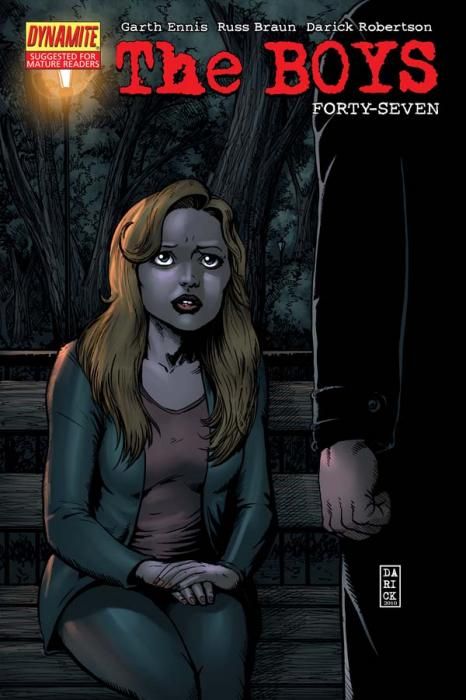This is the issue that many "Boys" fans have dreaded for a long time. Last issue, Hughie saw the tape showing what Annie (aka Starlight) did to get into the Seven. This issue is the fall-out. If you've been reading the "Highland Laddie" mini-series, then what happens isn't much of a surprise, but watching it happen is just as gutwrenching and unpleasant as it would be otherwise. The confrontation has been coming ever since the two became romantically involved and Ennis doesn't hold back. In fact, you might say he's a cruel bastard with how intense and emotional the scene is. But, to quote Butcher last issue: "Cruel to be kind." That's Ennis all over in this issue.
The build to Annie and Hughie's confrontation occurs in two scenes, one between Hughie and Butcher, the other between Annie and Queen Maeve. The conversation between Hughie and Butcher sets the scene well with Butcher carefully nurturing the worst feelings Hughie is having, manipulating him to a degree. Russ Braun's art helps get that idea across with how he shows Butcher looking when Hughie is out of the room and when he's in it. Butcher overplays his reactions; normally, he's much more stoic, but he's very expressive when talking to Hughie. It's the sort of thing that the reader notices, while Hughie is totally blind to it, so wrapped up in his own problems. At the same time, it's not a completely cold and calculating play on Butcher's part. Ennis and Braun walk the line between the two poles well here; Ennis' words pushing more towards sincerity, while Braun's art pushes more towards manipulation, and the results being a mixture of the two.
While the focus is clearly on Hughie and Annie, this issue also handles the finale of the 'Believe' event by continuing the plot began during last year's "Herogasm" of the Homelander wanting to push for more independence from Vought-American. The way in which he does it here is both funny and monstrous. His casual brutality is underscored by and set in contrast to Hughie's passionate, angry words to Annie. Hughie is clearly the heart of this book and to see him act as he does is painful. Understandable and painful. Ennis throws everything into the scene and it lives up to the years of build-up.
Braun's expressive art adds so much to the issue. From his portrayal of Butcher to the cold, emotionless look on the Homelander's face to the mixture of rage and pain on Hughie's face, much of the necessary character parts of the comic come through the art. "The Boys" has always been a strong mixture of writing and art, and Braun continues that tradition, and, as he was quick to point out in a CBR interview, a big reason why that's true is colorist Tony Aviña: "Tony's colors not only enhance the mood and tone of the book, they just about define the look of 'The Boys.'"
Take a look at the first page of the comic and Aviña's dull, grey colors for Hughie vomiting. He looks like a dead man, hammering home what's going on inside. The mixture of Braun's expressive art and Aviña's smart and consistently great colors keep the visual quality of the comic high.
It's hard to read the second half of "The Boys" #47, because Ennis writes the scene with just as much emotion and pain and cruelty as the eventual confrontation between Hughie and Annie always implied. Their relationship has been a grounding part of the comic, something to draw the readers in and make them care. And, as expected (and dreaded), it all breaks apart, showing that "The Boys" is much more than superhero jokes and extreme violence. It's a comic that can break your heart, even when you can see it coming a mile away.

